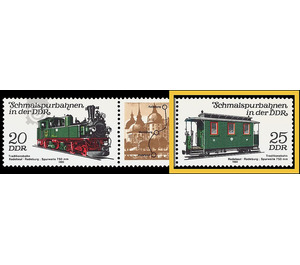Commemorative stamp series - Germany / German Democratic Republic 1980 - 25 Pfennig
Theme: Post & Philately
| Country | Germany / German Democratic Republic |
| Issue Date | 1980 |
| Face Value | 25.00 |
| Color | black |
| Perforation | K 13:12 1/2 |
| Printing Type | offset |
| Stamp Type | Postage stamp |
| Item Type | Stamp |
| Chronological Issue Number | 2306 |
| Chronological Chapter | GER-DDR |
| SID | 667434 |
| In 22 Wishlists | |
Narrow Gauge Railways in the GDR 1st Edition With the depiction of narrow gauge railways in the GDR, the Ministry of Posts and Telecommunications of the German Democratic Republic publishes two multicolour se-tenants. No special first-day cover handling Narrow Gauge Railways in the GDR In the seventies of the last century the railway network in the former Germany was essentially created; only in rural areas and difficult geographical regions was there still a need for railways of local importance. These were to supplement the network of normal gauge railways in many ways and were built for reasons of economy mostly narrow gauge with gauges between 600 and 1000 mm. In the area of the GDR, eight narrow-gauge railways will continue to be preserved as technical monuments in the future, opening up particularly attractive routes and serving tourism. Narrow gauge Radebeul Ost-Radeburg From the Dresden-Leipzig / Berlin main line, the 750-mm narrow gauge line branches off to the northeast in the Radebeul Ost station. The route runs from the Elbe and Lößnitztal curvy beyond the Moritz plateau on the edge of the Laußnitzer heath. With a minimum radius of 40 m and a maximum gradient of 16.7 o / oo, this route has difficult operating conditions. At the track is a popular destination Moritzburg - known by the hunting lodge of the former Saxon royal house. The route was built in 1884 and is 16.5 km long. On 10 August 1974, this route was declared by the Deutsche Reichsbahn "traditional train", since then in conjunction with the German Model Railway Association of the GDR in each summer with popular vehicles special tours performed, which are also many passengers dressed in historical clothes Participate at the turn of the century.


